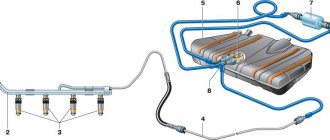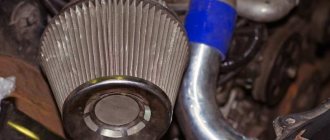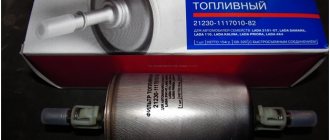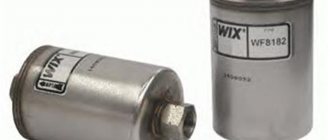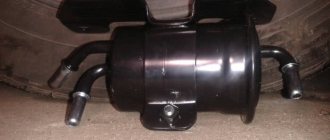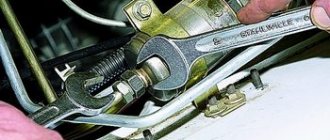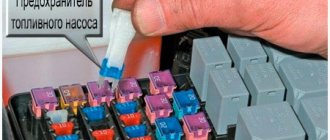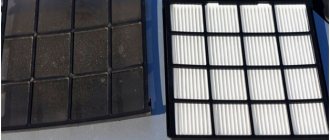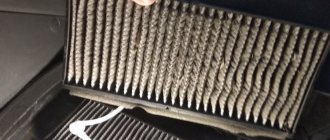Healthy nutrition is the key to long life and maximum performance of any car heart. Let’s clarify right away: this article is not about gasoline and diesel fuel.
- When and why should you change the fuel filter on your car? Video:
- Replacing the fuel filter, video:
Its main “heroes” will be those who guard the safety of the “iron horses” - fuel filters. We will tell you in this article what role they play in the life of a car, the difficulty of choosing them and how important it is to replace the fuel filter in a timely manner.
There is a similar article on this topic - Replacing the cabin filter.
What is a fuel filter
The filter device is the most important part of the fuel system. It filters and neutralizes rye/dirt particles contained in containers where fuel is stored and transported. In addition, it “frees” the working mixture from inclusions of water that form on the surface of the gas tank. Due to the chemical processes occurring during engine operation, impurities enter the fuel, and then into the power unit, killing it. The main purpose of the filter element is to destroy water, since its presence in the working mixture leads not only to wear, but to the “death” of the motor. The filter element allows the power unit to operate smoothly, without failures.
Types of fuel filters
What does the filter protect against?
It’s no secret to anyone that the fuel at our gas stations is not of first-class quality. Therefore, it may contain scale, sand or rust; the filter can stop all these particles. If something foreign gets into the fuel, the engine will wear out much faster.
Clogged filters should absolutely not be used, as they simply will not cope with their task. That is why every driver should know how to replace a gasoline fuel filter.
Types of filter elements
Depending on what fuel the vehicle is oriented towards, a specific filter device is installed in it. Let's talk about them in a little more detail.
Carburetor filter
Since a carburetor engine has low pressure, the working mixture enters the engine through special rubber hoses. that the filter element “crashes” . This can be a product made of plastic or metal. The product has 2 tubes (inlet/outlet). For maximum reliability, the hoses are secured using special clamps.
Injector filter
The peculiarity of this element is the transfer of a key function to a central electronic unit . The working mixture enters the engine under high pressure, and this requires the presence of metal fuel lines of the highest quality. If we talk about the fuel pump itself, it is made of steel or other particularly durable metals. Threaded elements are used as connectors.
Diesel filter
Diesel engine fuel is considered the “dirtiest” of those existing today; it requires increased purification from all kinds of impurities. Paraffins pose the greatest danger to the internal elements of a car. They, transforming into crystals, clog the main gaps in the parts. Therefore, vehicles running on diesel fuel are usually equipped with two filtering devices – the main one and the additional one. This allows you to clean the fuel from unnecessary impurities by 100%.
Types of filters
In addition, filter elements installed on vehicles differ in the following characteristics :
- degree of cleaning (coarse/fine);
- type of casing (metal/plastic);
- working pressure (high/low);
- type of fuel (diesel/gasoline).
Where is the filter located in the car?
Before moving on to the question of how to replace the fuel filter, you need to figure out where exactly it is located. Guided by the task assigned to the filter element, the most logical place for its location is on the way from the gas tank to the engine .
Moreover, the location of the filter varies greatly among different brands of cars.
For example, Japanese manufacturers make a filter in the same housing as the fuel pump. Install the device directly in the gas tank. But this design has two significant drawbacks:
- The fuel filter can only be replaced at a car service center;
- Often the breakdown of a given device is immediately followed by a complete replacement of the unit.
If we talk about the domestic automobile industry, then on the VAZ “classic” the filter is located under the hood, this facilitates convenient monitoring of the condition of the fuel filter and its quick replacement. On later Lada cars, the filter device was “hidden” in the rear beam, under the bumper.
Well, if we speak generally about the most popular locations for the fuel filter, we can list the following:
- rear bumper;
- in a niche on the bottom;
- in the fuel tank;
- engine compartment or in the engine compartment.
A separator/FPO can be installed separately (on the frame) in the vehicle.
Fuel filter location
Frequency of replacement of the filter device
The working life of the filter element is influenced by many conditions: the quality of the fuel being poured, the technical condition of the fuel system, the operating conditions of the vehicle, etc.
Manufacturers recommend changing the fuel filter every 30-40,000 km. But in reality, the need to replace it arises much more often . Which is caused by the following:
- the pipes become clogged and oxidized;
- rust forms;
- low quality fuel is used;
- The installed filter itself was of poor quality.
During the operation of the car, plaque forms inside the rubber/copper tubes in the fuel system, and oxides and rust accumulate on the metal elements. This means that the older the car is, the faster its filter device becomes clogged.
Therefore, not only the mileage on the speedometer should be a reason to replace the fuel device.
Symptoms of the need to replace the TF
The degree of contamination on filters with a transparent body can be easily determined visually. The filter that needs to be replaced has darkened, and the fuel entering it also loses its transparency.
If a different type of filter is installed in the car, the following signs will signal a replacement:
- The car began to twitch while driving (this is especially noticeable when climbing).
- The engine constantly stalls.
- Fuel consumption has increased.
- The power of the power unit has decreased.
No motorist is safe from pouring bad fuel into the tank (gasoline/diesel). As for the quality of the filter element itself, everyone chooses the product themselves in accordance with the necessary characteristics and their own financial capabilities.
BUT! When buying a filter element, it is wise not to rush for cheap ones, but to purchase original filters from trusted manufacturers.
Replacing the fuel filter
Replacing the fuel filter
The basic procedure for replacing the filter element on most types of cars is similar - at the end of the life of the filter element, the old device is removed and a new filter is installed in its place.
The main distinguishing feature of different engines is the location of the filter itself . And the complexity of the work and other details depend on this
To dismantle/install the TF in vehicles with different types of engines, special tools and accessories may be required. They need to be prepared in advance. Next, we will tell you how to change the filter for each specific type of engine, explaining how to remove the old one and install a new filter device.
Replacing the TF on the carburetor
In a carburetor engine, the filter device is usually located under the hood. It is made of plastics/light alloy metals, and its installation will be simple and understandable for everyone.
First, you need to remove the clamp on each side, then dismantle the filter device itself. When installing a new TF, it is extremely important to install it correctly, without confusing the direction (inlet/outlet). To make it easier for the car owner to navigate, there is an arrow on the body, which should point towards the gas tank when installed.
Having put the clamps in place, you need to pump in fuel using the fuel pump handle. If at this moment a slight whistle is heard, the seal is broken. Metal clamps will help ensure reliable fastening.
Important! The fuel device must not come into contact with the cap on the head and the block body.
Replacing the filter on the injector
Replacing the TF on the injector
The supply of the working mixture to the cylinders of an injection engine occurs under high pressure, and therefore the fuel pumps for such engines are made of metal with threaded fasteners at the connections. The injector TF can be located in the engine compartment or under the bottom .
- First, you need to reduce the pressure in the system, for which you need to remove the middle one in the safety block, which is located at the gear lever (usually it is responsible for the functioning of the pump).
- Then you need to start the engine and wait until it stalls (usually no more than a minute).
- Next, using the appropriate tools, dismantle the old filter and install a new one. Here the arrow should point in the direction of fuel flow.
After finishing the work, you need to put the fuse in place. After this, try to start the power unit.
Surely, the first attempt will not bring results, since it takes some time to stabilize the working pressure in the system.
Replacing TF on a diesel engine
In conclusion, we will tell you how to change the filter on cars with a diesel engine, which are extremely sensitive to the characteristics of the fuel being poured. A significant volume of impurities clogs the injectors, and this affects the correct operation of the power unit.
We have already mentioned above that diesel cars have 2 filters (pre-filter/fine filter). The second one usually needs to be changed after 10-15,000 km. It is located in the front part of the car, and to get to it, you will need to remove the wheel with the fender liner . After this you need to do the following:
- Roll up the tray.
- Remove the chip from the water meter.
- Remove the fittings by pressing the buttons located on the back wall.
- Remove the water level meter and the plug at the bottom.
- Provide the dismantled parts with new parts that ensure tightness (rubber gaskets/washers are supplied with the filter).
- Place a water meter with a plug on the filter device being installed, then place it on the machine.
During installation, do not hit the water meter - all work must be carried out with the utmost care.
The color marks on the filter device and the color of the fittings will help you check the correct assembly - they must match!
Replacing a filter on a diesel engine
And in order for the car to start after completion of work, before installation you need to fill the new fuel filter with diesel fuel. To expel excess air, you can rotate the starter for 5-7 seconds, after first squeezing each nozzle a little. After 2-3 similar procedures, small bubbles appear near them. Holding the injectors on the driver's side, you need to repeatedly rotate the starter several times. After this you need to clamp the remaining ones. These steps will help start the car engine.
Why are they even needed?
Forced fuel cleaning is a necessity to ensure the performance of any engine running on liquid fuel. Filling the filter cavity, gasoline passes through a layer (there may be several of them) of filter material, leaving on its surface particles of dust, dirt and other solid inclusions that adversely affect engine parts.
If the “food” ration of a car engine is diesel fuel, then an additional separator is required that will help clean the fuel, in addition to mechanical inclusions, from water content.
Its operating principle is based on the fact that water is heavier than diesel fuel, and centrifugal force helps separate them from each other. Due to the specific operation of separators, most of them are heated.
What are they, fuel filters?
There are three main groups:
- fuel pre-cleaning filters;
- fine fuel filters;
- fuel separators.
The first group is not very popular for passenger car engines. In them, the removal of large and small particles of impurities from the fuel is entrusted to one filter.
The second group is the most common. Filters of this type can be either case-mounted with threaded fastening, or in the form of filter elements that do not contain metal.
The difference between coarse and fine filters is mainly in the paper. If preliminary cleaning involves retaining particles measuring 75-100 microns, then final cleaning in the best filters allows you to retain particles up to 3-5 microns in size.
Filter elements can be designed with metal covers (for reliable fastening of the filter material) and can be designed with or without reinforcing mesh. Both are always installed in housings made of heat-resistant material.
This design provides for the presence of repair kits, since re-installation of sealing rubber bands and copper washers is not recommended.
It should be noted that the most popular filter material for fuel filters is paper.
Having been born more than a hundred years ago due to a technological error, it is still firmly in the lead among all filter materials.
To extend the service life of the filter, increase the filtration area and thereby improve the quality of the process itself, the paper is installed in the form of corrugations. The density of the folds in it is such that a “curtain” more than one meter long can fit in an “accordion” with a diameter of 100 mm.
By the way, in the cost of a fuel filter, the cost of filter paper is more than 60%, which means that the manufacturer can reduce its price only by losing quality!
Recently, filter materials based on propylene have been increasingly used and have already earned the approval of motorists. A small sector among filter elements is occupied by those made of fine-pored metal mesh.
The classic shape of fuel filters is the cylinder. Replacement cartridges for separators can be rectangular in shape in a metal or plastic case.
Don't forget about safety
- Before replacing elements of the fuel system, it is necessary to disconnect the ground on the battery - this will protect against the appearance of an accidental spark and ignition of the fuel.
- It is better to carry out work at moderate temperatures. If you need to replace it in the summer in the heat, you need to avoid direct sunlight.
- Smoking and using open flames while working is strictly prohibited.
You should not be negligent in cleaning the fuel - this will shorten the life of the power unit!
The filter device is not so expensive that you can save on it, and replacing it does not require much skill and knowledge. Therefore, it makes no sense to save on it. Since replacing a piston or overhauling an engine will cost a lot.
Regularity of TF replacement
Situations often occur when the engine begins to “tweak” when gas is added. If you do not respond to this in a timely manner, then in the near future the engine will begin to stall. And then the car owner begins to look for the reasons for this failure. The reasons, of course, can be very different, but most likely this was caused by clogged TF . Many automakers assure that the service life of this element is equal to the period of use of the car, although in practice it has been proven that this is not the case, and the filter element must be replaced after 20,000 km.
Fuel filter
If you want to increase the period of stable and efficient operation of a car engine, then do not forget about such a small but extremely important element of the fuel system as a filter device! Timely replacement of the filter will save you from expensive repairs.

